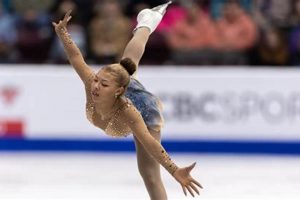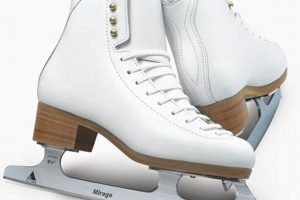Protective coverings designed to slip over the blades of figure skates, typically made of absorbent materials such as terry cloth or synthetic fabrics, are crucial for maintaining blade condition. These coverings prevent rust formation by wicking away moisture after use. For example, skaters place these soft guards on their blades immediately after stepping off the ice.
The implementation of these blade protectors offers significant advantages, extending the lifespan of expensive skate blades by mitigating corrosion. They also safeguard skate bags and other equipment from sharp edges. Historically, skaters used rudimentary materials for this purpose; however, modern advancements have led to more effective and durable options, reflecting a deeper understanding of blade preservation.
Further discussion will address the specific materials utilized in these blade covers, proper usage techniques to maximize effectiveness, and factors to consider when selecting appropriate protectors based on blade type and skating frequency. Maintenance of these coverings is also relevant to their longevity and continued performance.
Tips for Maximizing Blade Protection
Proper care and maintenance of blade coverings are essential for preserving the integrity of figure skate blades and ensuring optimal performance. The following tips provide guidance on extending the life and effectiveness of these protective accessories.
Tip 1: Choose Absorbent Materials: Prioritize coverings constructed from highly absorbent materials, such as terry cloth or microfibers, to efficiently draw moisture away from the blades. Ensure the material’s density is sufficient to prevent saturation.
Tip 2: Immediate Application is Key: Affix blade coverings immediately after exiting the ice surface. Delaying this process allows moisture to linger on the blade, increasing the risk of rust formation. A quick transition is crucial.
Tip 3: Regular Cleaning is Recommended: Periodically wash blade coverings to remove accumulated moisture, dirt, and debris. Follow the manufacturer’s instructions for cleaning, and ensure they are completely dry before subsequent use.
Tip 4: Proper Storage Matters: After use and cleaning, store the coverings in a well-ventilated area. Avoid sealing them in airtight containers while damp, as this promotes bacterial growth and mildew formation.
Tip 5: Alternate Between Sets: Consider having multiple sets of coverings. This allows for rotation and ensures that a clean, dry set is always available, preventing the reintroduction of moisture to the blades.
Tip 6: Inspect for Wear and Tear: Regularly examine coverings for signs of damage, such as tears, fraying, or diminished absorbency. Replace worn or damaged coverings promptly to maintain adequate blade protection.
Tip 7: Size Appropriately: Ensure that the coverings are correctly sized for the skate blades. Overly large coverings may not provide adequate protection, while excessively small ones may be difficult to apply and remove.
Adhering to these guidelines will contribute to the prolonged lifespan of skate blades, minimize the risk of corrosion, and maintain the overall condition of skating equipment. The consistent application of these practices represents a sound investment in equipment preservation.
The subsequent sections will delve into specific types of blade coverings, addressing the nuances of material composition and design variations within the market.
1. Absorbent Material Selection
The choice of absorbent material is foundational to the effectiveness of figure skate blade protectors. The material’s capacity to wick away moisture directly influences the prevention of corrosion and the preservation of blade integrity.
- Moisture Absorption Rate
Different materials exhibit varying rates of moisture absorption. Terry cloth, for example, offers a high absorption rate due to its looped pile construction, while synthetic microfibers can provide rapid wicking action. The selection of a material with a superior absorption rate is critical in preventing prolonged exposure of the blade to moisture, a primary catalyst for rust formation.
- Material Density and Composition
The density of the absorbent material impacts its overall capacity to retain moisture. A denser material can absorb a greater volume of water, providing extended protection. Moreover, the material’s composition influences its longevity and resistance to degradation. Natural fibers may be more susceptible to mildew and breakdown compared to synthetic alternatives, affecting the long-term effectiveness of the blade protector.
- Drying Time of the Material
The speed at which the material itself dries after absorbing moisture is a significant factor. A material that remains damp for extended periods can create a humid environment conducive to corrosion. Materials with quick-drying properties are preferable, as they minimize the duration of exposure to moisture and reduce the likelihood of bacterial growth within the protector.
- Maintenance and Longevity
The ease of cleaning and the overall durability of the absorbent material influence the long-term value of the skate blade protectors. Materials that are easily washable and resistant to wear and tear maintain their effectiveness over time. Regular cleaning is essential to remove accumulated salts and debris, preventing them from acting as corrosive agents on the blade surface.
The proper selection and maintenance of absorbent materials in blade protectors directly impact the lifespan and performance of figure skate blades. Optimizing these factors is a critical component of comprehensive skate care, contributing to both cost savings and enhanced skating experience.
2. Rust Prevention Effectiveness
The efficacy of figure skate blade protection directly correlates with the reduction of rust formation on the blades. The level of rust prevention is a critical factor in determining the lifespan and performance of figure skates, and proper maintenance protocols, specifically the utilization of protective coverings, are essential for achieving optimal results.
- Material Absorbency and Moisture Control
The primary mechanism through which protective blade coverings prevent rust is by absorbing moisture from the blade surface after use. Highly absorbent materials, such as terry cloth or microfiber, effectively draw moisture away from the blade, preventing prolonged exposure to humidity. Insufficient absorbency or inadequate coverage leaves the blade susceptible to corrosion, even within a relatively short timeframe.
- Ventilation and Drying Environment
While absorbency is crucial, the environment within the blade covering also influences rust prevention. A well-ventilated covering allows for air circulation, facilitating the evaporation of any residual moisture. Conversely, an airtight covering traps moisture, creating a humid microclimate that accelerates rust formation. The design of the covering should, therefore, prioritize breathability to promote effective drying.
- Frequency and Duration of Usage
The frequency with which protective coverings are used, and the duration for which they remain on the blades, significantly impact rust prevention. Consistent application immediately after skating minimizes the time the blades are exposed to moisture. Leaving damp coverings on the blades for extended periods, however, can exacerbate corrosion. Regular cleaning and rotation of coverings are essential for maintaining their effectiveness.
- Material Composition and Anti-Corrosive Properties
Beyond absorbency and ventilation, certain materials may possess inherent anti-corrosive properties. Some manufacturers incorporate materials treated with rust inhibitors or coatings designed to repel moisture and prevent oxidation. While not a substitute for proper moisture control, these added features can provide an additional layer of protection against rust formation.
The effectiveness of rust prevention strategies relies on a multifaceted approach that encompasses material selection, environmental control, usage patterns, and potential anti-corrosive properties. Consistent and diligent application of appropriate blade protection protocols is essential for maximizing the lifespan and performance of figure skates. The proper care and maintenance should be prioritized by skaters of all levels.
3. Blade Protection Duration
The period during which figure skate blade coverings effectively safeguard against corrosion and physical damage is a critical factor in equipment maintenance. The duration of effective protection is intrinsically linked to the material properties, usage patterns, and environmental conditions affecting the coverings.
- Material Degradation Over Time
The constituent materials of blade coverings undergo degradation with repeated use and exposure to moisture. Terry cloth may lose its absorbency due to fiber breakdown, while synthetic materials can develop micro-tears that compromise their integrity. The rate of degradation directly impacts the duration for which the coverings provide adequate protection, necessitating periodic replacement to maintain effectiveness.
- Environmental Factors Influencing Longevity
The surrounding environment exerts a considerable influence on the lifespan of blade coverings. High humidity levels and exposure to direct sunlight accelerate material breakdown and promote the growth of mold and bacteria. Conversely, dry and well-ventilated storage conditions prolong the effective lifespan of the coverings. Maintaining appropriate storage practices is essential for maximizing blade protection duration.
- Impact of Usage Frequency and Intensity
The frequency and intensity of skating sessions influence the rate at which blade coverings become saturated with moisture and subjected to wear and tear. Skaters who train daily or engage in rigorous training regimens require more frequent cleaning and replacement of coverings compared to recreational skaters. The intensity of usage directly correlates with the diminished blade protection duration.
- Maintenance Practices and Cleaning Protocols
Adherence to proper maintenance practices significantly extends the effective lifespan of blade coverings. Regular washing removes accumulated salts, dirt, and debris that contribute to corrosion and material degradation. Utilizing appropriate cleaning agents and ensuring thorough drying after washing prevents the growth of mold and bacteria. Consistent maintenance protocols directly enhance blade protection duration.
The interplay between material degradation, environmental factors, usage patterns, and maintenance practices dictates the practical blade protection duration. Regular inspection and timely replacement of worn or damaged coverings, coupled with diligent maintenance, are crucial for ensuring continuous and effective protection against corrosion and physical damage to figure skate blades.
4. Equipment Storage Hygiene
Equipment storage hygiene plays a crucial role in preserving the condition and extending the lifespan of figure skating equipment, particularly in conjunction with protective blade coverings. Proper storage practices mitigate the detrimental effects of moisture, dirt, and environmental factors on blade integrity and overall equipment performance.
- Ventilation and Moisture Control
Adequate ventilation within skate bags and storage areas is paramount for preventing moisture accumulation. Enclosed, poorly ventilated spaces promote the growth of mold and bacteria, accelerating corrosion of skate blades despite the presence of protective coverings. Allowing air circulation facilitates the evaporation of residual moisture absorbed by the coverings, thus maintaining a dry environment conducive to blade preservation. Failure to ensure proper ventilation negates the benefits of absorbent materials.
- Protective Coverings Maintenance and Rotation
The hygiene of the blade coverings themselves is integral to effective equipment storage. Damp or soiled coverings can become breeding grounds for microorganisms that contribute to blade corrosion. Regular washing and thorough drying of protective coverings are essential for maintaining their hygienic state. Rotating between multiple sets of coverings allows each set to fully dry between uses, preventing the reintroduction of moisture to the blades.
- Bag Cleanliness and Debris Removal
The interior of skate bags often accumulates dirt, ice shavings, and other debris that can harbor moisture and accelerate equipment degradation. Periodic cleaning of skate bags, including vacuuming and wiping down surfaces, removes these contaminants and minimizes the risk of corrosion. Neglecting bag cleanliness introduces abrasive particles that can damage blade surfaces, even when protective coverings are in place.
- Temperature Control and Storage Location
Extreme temperature fluctuations and direct sunlight exposure can adversely affect both the skate blades and the protective coverings. Storing skate bags in cool, dry locations away from direct sunlight prevents material degradation and reduces the risk of condensation formation. Avoiding prolonged storage in excessively warm or cold environments preserves the structural integrity of the equipment and prolongs its lifespan.
These facets of equipment storage hygiene are interconnected and collectively contribute to the preservation of figure skating equipment. Consistent adherence to these practices, in conjunction with the use of blade coverings, ensures optimal blade condition and minimizes the risk of corrosion, extending the lifespan of expensive skating equipment and maintaining performance quality.
5. Cost-Effective Maintenance
The long-term affordability of figure skating hinges significantly on effective equipment maintenance. The utilization of protective blade coverings contributes directly to cost reduction by prolonging the lifespan of expensive skate blades and minimizing the need for frequent replacements or repairs. Proactive maintenance strategies represent a sound investment, mitigating the financial burden associated with equipment degradation.
- Reduced Blade Sharpening Frequency
Consistent use of figure skate blade protectors minimizes nicks and scratches on the blade edges. Abrasive surfaces encountered during transportation and storage can dull the blade over time, necessitating frequent sharpening. By mitigating this wear, protective coverings extend the intervals between sharpening sessions, translating to direct cost savings. Sharpening, while essential, gradually reduces the blade’s thickness, shortening its overall lifespan.
- Prevention of Rust and Corrosion
Moisture exposure is a primary catalyst for rust and corrosion, which weakens the blade structure and compromises its performance. Protective blade coverings, crafted from absorbent materials, effectively wick away moisture after use, preventing the formation of rust. The cost of replacing corroded blades far exceeds the investment in preventive measures such as blade protection. Furthermore, rust can lead to uneven blade surfaces, negatively impacting skating technique.
- Extended Blade Lifespan
The cumulative effect of reduced sharpening frequency and rust prevention is a significantly extended blade lifespan. Blades that are well-maintained and protected from damage can last for several seasons, depending on usage intensity. The initial investment in high-quality blades is best realized when coupled with proactive maintenance strategies, maximizing their useful life and deferring the need for costly replacements. This approach aligns with sustainable practices in sports equipment management.
- Minimization of Repair Costs
Severe damage to skate blades, such as deep gouges or bends, often necessitates professional repair or complete replacement. The use of protective coverings reduces the likelihood of such damage occurring during storage and transport. By safeguarding against physical trauma, these coverings minimize the potential for costly repairs and downtime, allowing skaters to maintain consistent training schedules. Prevention is invariably more cost-effective than remediation in the context of skate maintenance.
In summary, the strategic integration of figure skate blade coverings into a comprehensive maintenance plan yields substantial cost savings over time. The benefits extend beyond mere monetary considerations, encompassing improved blade performance and enhanced skating experience. A proactive approach to equipment maintenance, centered on the utilization of protective coverings, represents a prudent investment in the long-term sustainability of figure skating activities.
Frequently Asked Questions
This section addresses common inquiries regarding figure skate blade coverings, offering detailed explanations to enhance understanding and optimize their utilization.
Question 1: How frequently should figure skate blade coverings be washed?
The washing frequency of blade coverings depends on usage intensity. Daily skaters should wash coverings weekly, while recreational skaters can extend this interval to bi-weekly. Accumulated salts and debris compromise material integrity; regular washing prevents corrosion.
Question 2: What materials are most effective for moisture absorption in blade coverings?
Terry cloth and microfiber are regarded as highly effective materials for moisture absorption. Terry cloth provides superior absorbency due to its looped pile construction, while microfibers offer rapid wicking action. Material choice impacts blade protection directly.
Question 3: Is it necessary to remove blade coverings immediately after skating?
Prompt removal of blade coverings after skating is essential. Damp coverings trap moisture against the blade, promoting rust formation. Removing coverings allows blades to air dry, minimizing corrosion risk. Delaying removal negates the protective benefits.
Question 4: Can blade coverings be stored in an airtight container after use?
Storing damp blade coverings in airtight containers is not recommended. Sealed environments foster bacterial growth and mildew formation, degrading material integrity. Coverings should be stored in well-ventilated areas to facilitate drying.
Question 5: How does the color of blade coverings impact their effectiveness?
The color of blade coverings has no direct impact on their functional effectiveness. Color is a matter of personal preference and aesthetic appeal. Material composition and construction are the primary determinants of blade protection.
Question 6: Are blade coverings a substitute for proper blade sharpening?
Blade coverings are not a substitute for blade sharpening. While coverings protect against nicks and scratches, they do not maintain blade edges. Regular sharpening is essential for optimal skating performance. Coverings complement sharpening efforts.
Consistent utilization and diligent maintenance of figure skate blade coverings constitute a fundamental aspect of skate care, preserving blade integrity and ensuring optimal performance.
The subsequent section will delve into specific brands and models of blade coverings, offering comparative analyses based on user feedback and material specifications.
Conclusion
The preceding analysis has thoroughly examined the critical role of figure skate soakers in maintaining blade integrity and optimizing the lifespan of figure skating equipment. The comprehensive overview has addressed material selection, rust prevention, protective duration, storage hygiene, and cost-effective maintenance. Consistent application of the discussed principles remains paramount.
The informed selection and diligent care of these blade protectors represent a significant investment in equipment preservation. Skaters and coaches alike should prioritize adherence to the recommended maintenance protocols to maximize performance and minimize the financial burden associated with blade replacement. Future advancements in material science may further enhance the protective capabilities of these essential accessories, solidifying their importance in the sport.







